博文
敬复杨正瓴先生---人头骨为什麽不是圆的?
|
尊敬的杨老师:
您好,关于您提出的“人头骨为什麽不是圆的?”的问题,由于我才学有限,只能将我的一点认识做一些讲述:
1:进化的缘故。我不是学生物学的对这点讲不清楚,但是也查了一下相关的问题,大概讲述了西班牙发现的人类进化的遗迹问题,虽然不是中国人但也可以说明这类人类进化问题的一个环节。对于进化论可能协和保留的由裴文中先生 等发掘的周口店猿人更说明问题,可是那个太久远了,而且实物找不到了。
这个新闻也是个旧文大约是2013年12月4日英国BBC科学与环境栏目报道的,
还一个是2015年9月10日Kristina Killgrove 报道的,附在最下面。
当然这两个报道并没有直接回答您的提问,这只是说明人骨骼进化发展的问题 。也只是我的一个主观想法 。
先看2013年的 《在40万年的人类大腿骨中发现DNA将在我们祖先的研究中开辟一个新的前沿》这是一则BBC的新闻报道:
The discovery of DNA in a 400,000-year old human thigh bone will open up a new frontier in the study of our ancestors.
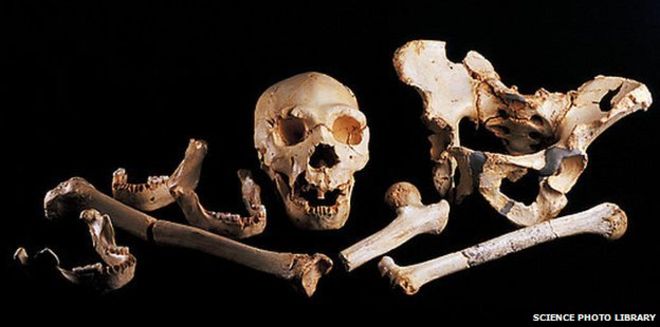
The discovery of DNA in a 400,000-year-old human thigh bone will open up a new frontier in the study of our ancestors.That's the verdict cast by human evolution experts on an analysis in Nature journal of the oldest human genetic material ever sequenced.
The femur comes from the famed "Pit of Bones" site in Spain, which gave up the remains of at least 28 ancient people.
But the results are perplexing, raising more questions than answers about our increasingly complex family tree.
The early human remains from the cave site near the northern Spanish city of Burgos have been painstakingly excavated and pieced together over the course of more than two decades. It has yielded one of the richest assemblages of human bones from this stage of human evolution, in a time called the Middle Pleistocene.
o access the pit (called Sima de los Huesos in Spanish) scientists must crawl for hundreds of metres through narrow cave tunnels and rope down through the dark. The bodies were probably deposited there deliberately - their causes of death unknown.
The fossils carry many traits typical of Neanderthals, and either belong to an ancestral species known as Homo heidelbergensis - or, as the British palaeoanthropologist Chris Stringer suggests - are early representatives of the Neanderthal lineage.
DNA's tendency to break down over time means it has not previously been possible to study the genetics of such ancient members of the human family.
But the recent pace of progress in sequencing technology has astonished many scientists: "Years ago, geneticists said they wouldn't be able to find DNA that was older than 60,000 years old," said co-author Jose Bermudez de Castro, from the National Research Centre for Human Evolution (CENIEH), a member of the team that excavated the fossils.
"Of course, that wasn't true. The techniques have advanced hugely."
Siberia to Iberia
Researchers at the Max Planck Institute for Evolutionary Anthropology in Leipzig, Germany, under the supervision of Prof Svante Paabo, have been helping drive those advances. The success reported in Nature was the result of applying techniques developed for sequencing the degraded DNA found in Neanderthal fossils to even older specimens.
Prof Paabo, the institute's director, said: "Our results show that we can now study DNA from human ancestors that are hundreds of thousands of years old," adding: "It is tremendously exciting."
The scientists were able to stitch together a near-complete sequence of mitochondrial DNA, or mtDNA (the genetic material contained in the tiny "batteries" that power our cells) from the ancient femur. But comparisons of the genetic code with that from other humans, ancient and modern, yielded a surprise.
Rather than showing a relationship between the Spanish specimens and Neanderthals, which might be expected based on their physical features, the mitochondrial DNA was most similar to that found in 40,000 year-old material unearthed thousands of kilometres away at Denisova Cave in Siberia.
The Denisovans were a sister group to the Neanderthals, with distinct genetic characteristics. Identified only by DNA extracted from a tiny finger bone and tooth, they are, as some researchers have remarked, "a genome in search of a fossil" because there are no substantial remains representative of this group.
By using missing mutations in the old DNA sequences, the researchers calculated that the Pit of Bones individual shared a common ancestor with the Denisovans about 700,000 years ago.
So there are several possibilities as to how Denisovan-like DNA could turn up in Middle Pleistocene Spain. Firstly, the mitochondrial DNA type from the pit came from a population ancestral to both the Spanish hominids and to Denisovans.
Secondly, interbreeding between the Pit of Bones people (or their ancestors) and yet another early human species brought the Denisovan-like DNA into this western population. Prof Bermudez de Castro thinks there may be a candidate for this cryptic ancestor: an earlier human species known as Homo antecessor. One million years ago, antecessor inhabited the site of Gran Dolina, just a few hundred metres away from the Pit of Bones.
Prof Chris Stringer, from London's Natural History Museum, told BBC News: "We need all the data we can get to build the whole story of human evolution. We can't just build it from stone tools, we can't just build it from the fossils. Having the DNA gives us a whole new way of looking at it."
However, he points out, mtDNA is a small and unusual component of our genetic blueprint, from which only limited conclusions can be drawn. For example, no sign of the interbreeding we now know took place between Neanderthals and modern humans remains in the mtDNA of modern people.
To get the full picture, scientists had to sequence nuclear DNA (that kept in the nuclei of cells) from Neanderthals and compare it with that in present-day populations. Likewise, the true relationships between the Pit people and other ancient populations may only be known if and when nuclear DNA is available.
This will be a challenge given the age of the Spanish fossils, but their good state of preservation - largely a product of the fairly constant temperature inside the cave - gives hope.
"That is our next big thing here, to sequence at least part of the nuclear genome from the individual in the Sima de los Huesos," Svante Paabo told BBC News.
"This will answer definitively the question of how they are related to Neanderthals, modern humans and Denisovans."
2015年9月10日Kristina Killgrove 的报道

Lateral view of the skull of DH1, a specimen of the newly-named hominin species Homo naledi. (Image by John Hawks; CC BY 4.0.)
In 1964, Louis Leakey and colleagues proposed the name of Homo habilis, the "handyman," for fossil remains of a human ancestor in Tanzania, making it the earliest species in a genus that includes us, Homo sapiens. This morning, Lee Berger and colleagues announced the discovery of another long-lost relative: Homo naledi. Intriguingly, this new species presents a skeleton with some features that are surprisingly modern and some features that are surprisingly archaic. But since it has not yet been securely dated, how exactly H. naledi fits into our evolution is still a bit murky.
Two years ago, a team of experts from around the world was assembled in order to document and collect hundreds of fossils found in the Dinaledi chamber of the Rising Star cave system in South Africa. Spelunking nearly 100 feet underground, a portion of the Rising Star Expedition team squeezed through narrow crevices, bringing in cameras to beam images of the fossils to the surface before removing them. The collection they amassed -- totalling 1,550 specimens of a hominin, or human ancestor -- represents at least 15 different individuals of the same species, astoundingly high numbers in palaeoanthropology, the field that studies human evolution. More to the point, these remains are all similar and yet "include traits not found in any other hominin species yet described," Berger and colleagues write today in the journal eLIFE.
Naming a new species is not undertaken lightly, and the decision to do so is based on distinctive features and appearances of fossil remains. Berger and colleagues compared the fossil bones and teeth found in Dinaledi cave to other known hominin specimens, including the robust and gracile australopithecines, Homo habilis, Homo erectus and ergaster, Homo floresiensis (or the "hobbit"), and "archaic" Homo sapiens, in an attempt to figure out if the Dinaledi remains could be classified with these already known species. Some of the most interesting bones in this case are those of the hands and feet.
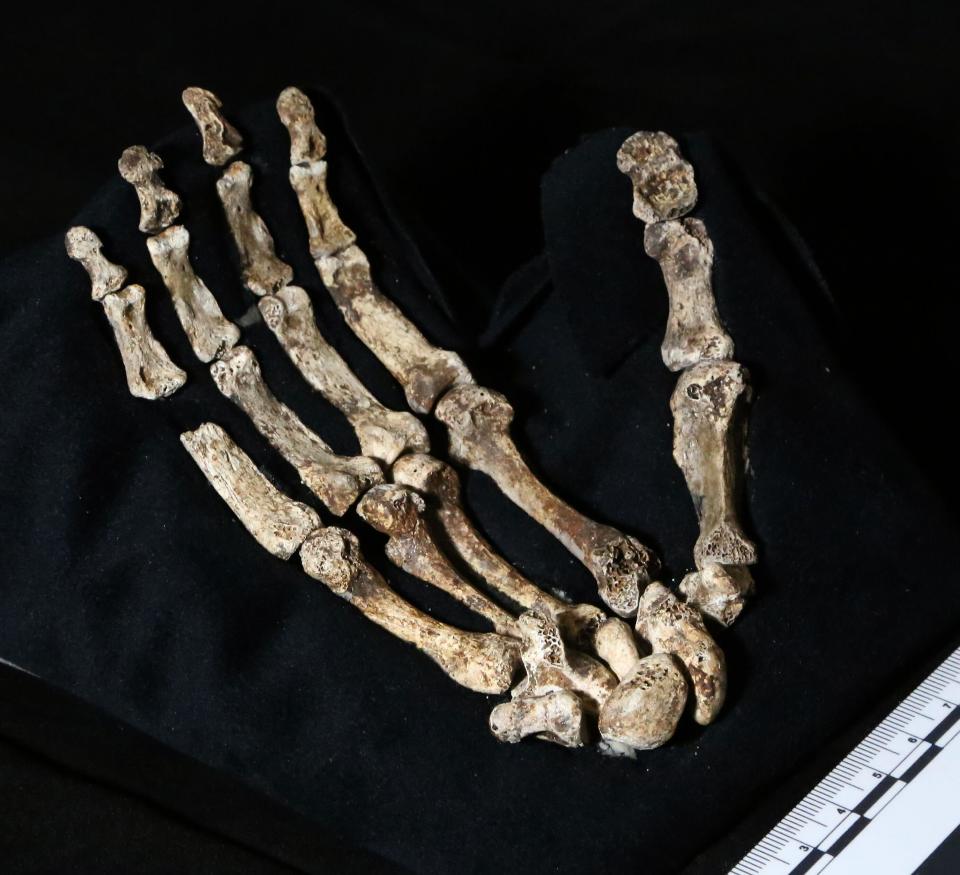
Figure 6 from Berger et al. 2015, eLIFE. Palmar view of right hand of Homo naledi. This hand was discovered in articulation, and all bones are represented except for the pisiform. The proportions of digits are humanlike and visually apparent, as are the expanded distal apical tufts on all digits, the robust pollical ray, and the unique first metacarpal morphology. (Image by John Hawks, CC BY 4.0.)
Hands are important in human evolution because our opposable thumbs are considered a key "derived" trait, or one that differs from the ancestral pattern. Our ability to grasp everything from a tree branch to a pencil is owed to our ancestors' evolution. What's intriguing about the hand of the new Homo naledi is that it "possesses a combination of primitive and derived features not seen in the hand of any other hominin," according to Berger and colleagues. In short, the shape of the first metacarpal, the bone that runs along the base of the thumb, means that H. naledi had a muscular, human-like hand.

Feet are also important in human evolution because we, unlike other primates, walk on them exclusively. Far back in our evolution, changes had to occur over time to our ancestors' skeletons to make bipedal walking efficient and useful. The foot bones of these new fossil individuals have much more in common with us than they do with older australopithecines and early members of our genus Homo. They do, however, have much lower arches than our feet do.
Two views (dorsal and medial) of the rearticulated right foot of Homo naledi. (Image by Peter Schmid, CC BY 4.0.)
But while Homo naledi boasts human-like hands and feet, as well as a body size similar to a small human and a skull of a similar shape, its brain was small and it has a ribcage, shoulders, and pelvis that are decidedly not similar to ours. Berger and colleagues call the skeletal structure of Homo naledi an "anatomical mosaic," meaning the new species has some features we expect to see in more ancient species and some features we expect to see in more recent species of hominin. "This species combines a human-like body size and stature with an australopith-sized brain," they write, as well as "features of the shoulder and hand apparently well-suited for climbing with humanlike hand and wrist adaptations for manipulation; australopith-like hip mechanics with humanlike terrestrial adaptations of the food and lower limb; small dentition with primitive dental proportions."
The key features of the Dinaledi fossils, though, place them within our genus. That is, the way H. naledi walked, grasped objects, and chewed food is more similar to our Homo ancestors than to earlier australopithecines. "The similarities of H. naledi to earlier members of Homo, including H. habilis, H. rudolfensis, and H. erectus," the authors explain, "suggest that this species may be rooted within the initial origin and diversification of our genus."
While H. naledi has not yet been securely dated, the shape of its skeleton likely places it early in our genus. "If the fossils prove to be substantially older than 2 million years," Berger and colleagues note, "H. naledi would be the earliest example of our genus that is more than a single isolated fragment." But if they're more recent, a date "younger than 1 million years ago would demonstrate the coexistence of multiple Homo morphs in Africa, including this small-brained form, into the later periods of human evolution." No matter the date, the unique form of these skeletons will start filling in gaps in the fossil record of early humans.
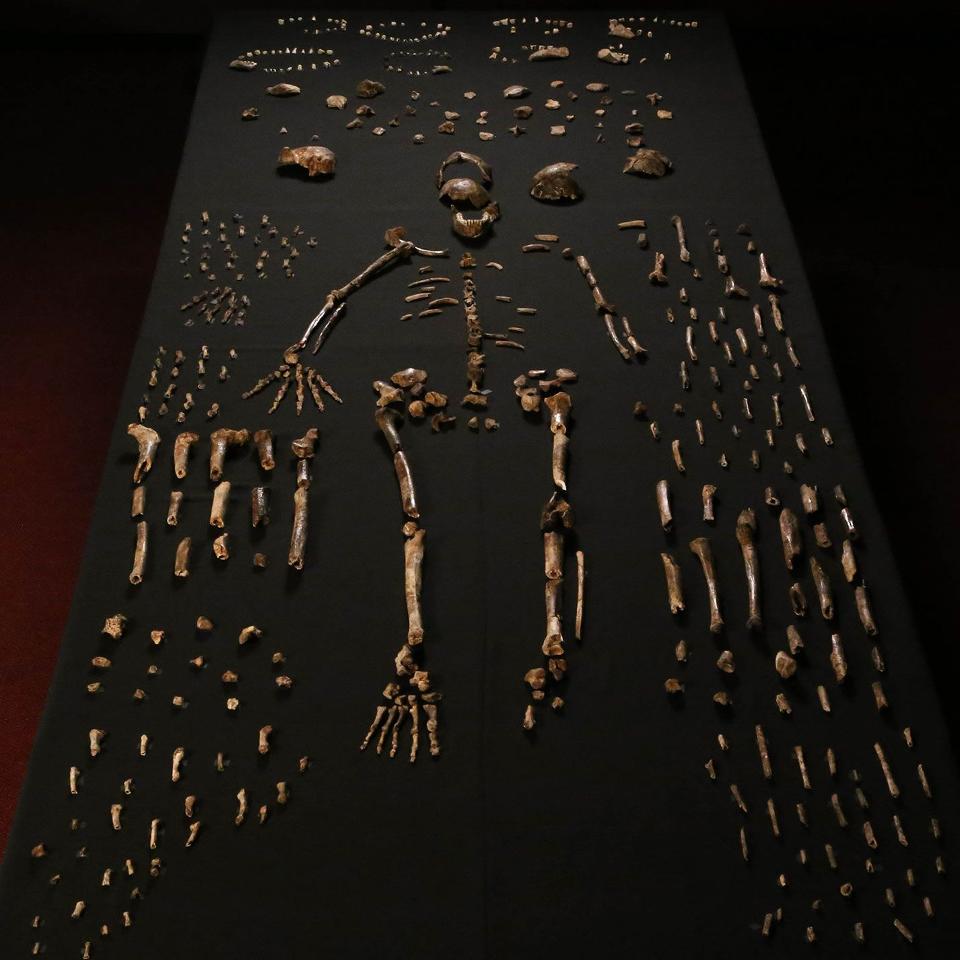
Dinaledi skeletal specimens. The figure includes approximately all of the material incorporated in this diagnosis, including the holotype specimen, paratypes and referred material. These make up 737 partial or complete anatomical elements, many of which consist of several refitted specimens. Specimens not identified to element, such as non diagnostic long bone or cranial fragments, and a subset of fragile specimens are not shown here. The ‘skeleton’ layout in the center of the photo is a composite of elements that represent multiple individuals. This view is foreshortened; the table upon which the bones are arranged is 120-cm wide for scale. (Image by John Hawks, CC BY 4.0; text from Figure 1 of Berger et al. 2015, eLIFE)
It is clear from the amazing work done in just two years by the Rising Star Expedition that the bar has been raised in palaeoanthropology, particularly in terms of classifying and naming new species in the future. The mosaic-like set of skeletal features represented in the hundreds of fossil remains from Dinaledi cave means that "we must abandon the expectation that any small fragment of the anatomy can provide singular insight about the evolutionary relationships of fossil hominins," Berger and colleagues caution. Mounting evidence of the evolution of different traits at different times in different populations means the fossil record of human evolution is much more complicated -- and much more interesting -- than we thought even a few decades ago.
The Dinaledi cave is in a way unique, having protected one of the largest and most comprehensive collections of hominin remains anywhere in the world, but Berger and his team are confident similar assortments exist elsewhere. They conclude their article by admitting that, while we do not yet know what the entirety of the Homo ancestral tree looked like, "with an increasing pace of discovery from the field and the laboratory, more light will be thrown on the origin of humans."
这是2015年9月10日的Kristina Killgrove 报道内容
我对生物进化不很了解,这些也只是看看大概意思。请杨老师自行释译更为妥帖。
2:头骨的自然进化决定了头骨结构的基本组成,各部分骨骼有自己的基本形状,组合起来形成头骨顶颅部分接近于不规则球体的基本形状。而面颅则与球体有更大区别,比方:下颌骨的横断面是五个转折的梯形,正面是左右门齿到尖牙、左右 尖牙到嚼牙、左右嚼牙到最后磨牙、左右下颌骨外翼 。这个基本形状就决定了人面颅下半部分不是圆形,附着肌肉、脂肪,也很难改变骨骼的形状,整容术也只是局部的削骨或做个假体之类很难改变骨骼的基本转折 。
对顶颅也是由于这些进化的骨骼原因,比方:顶骨上有人字缝 、冠状缝、 矢状缝等等结构,这些是顶骨、枕骨相交接的骨骼缝隙,由于人降生后,这些骨缝的闭合程度不同,所以会产生人顶骨会出现一些不同程度的凹陷呈现出来的顶骨的差异,有的人顶骨平些、有的顶骨尖些。
以下这张表现冠状缝是相对明显的:

头骨的骨骼骨点,这是解剖上认为规定的骨骼结构点,一般是对称的,两点连线是平行直线。比方:头骨最宽处的上下颞线、蝶骨、额骨结节、枕骨结节 、 顶突、 颧突等等。这些部分有的是骨骼形状的自然突起、有的是接近于平直,比方:颞骨、蝶骨部分,与顶骨相对球体的结构相连接形成方与圆的结合体,而不是球体的圆。对于学画者而言,认识头骨的结构对称点是人像造型的基础。
以下这张表现枕骨结节相对明确些:
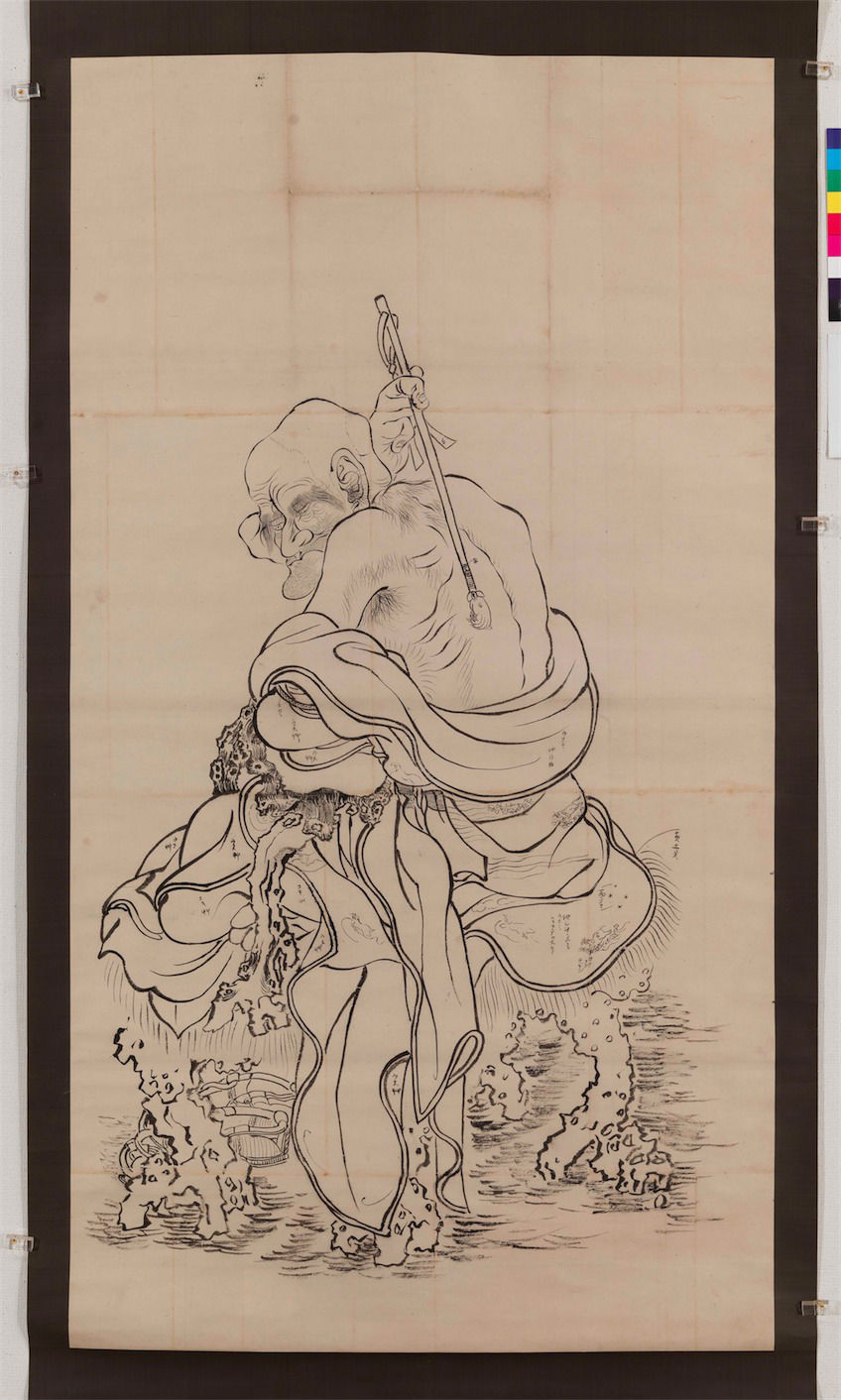
以下这张对于表现颞线、蝶骨相对明确些: 甚至头骨的矢状缝,表现的更明确。
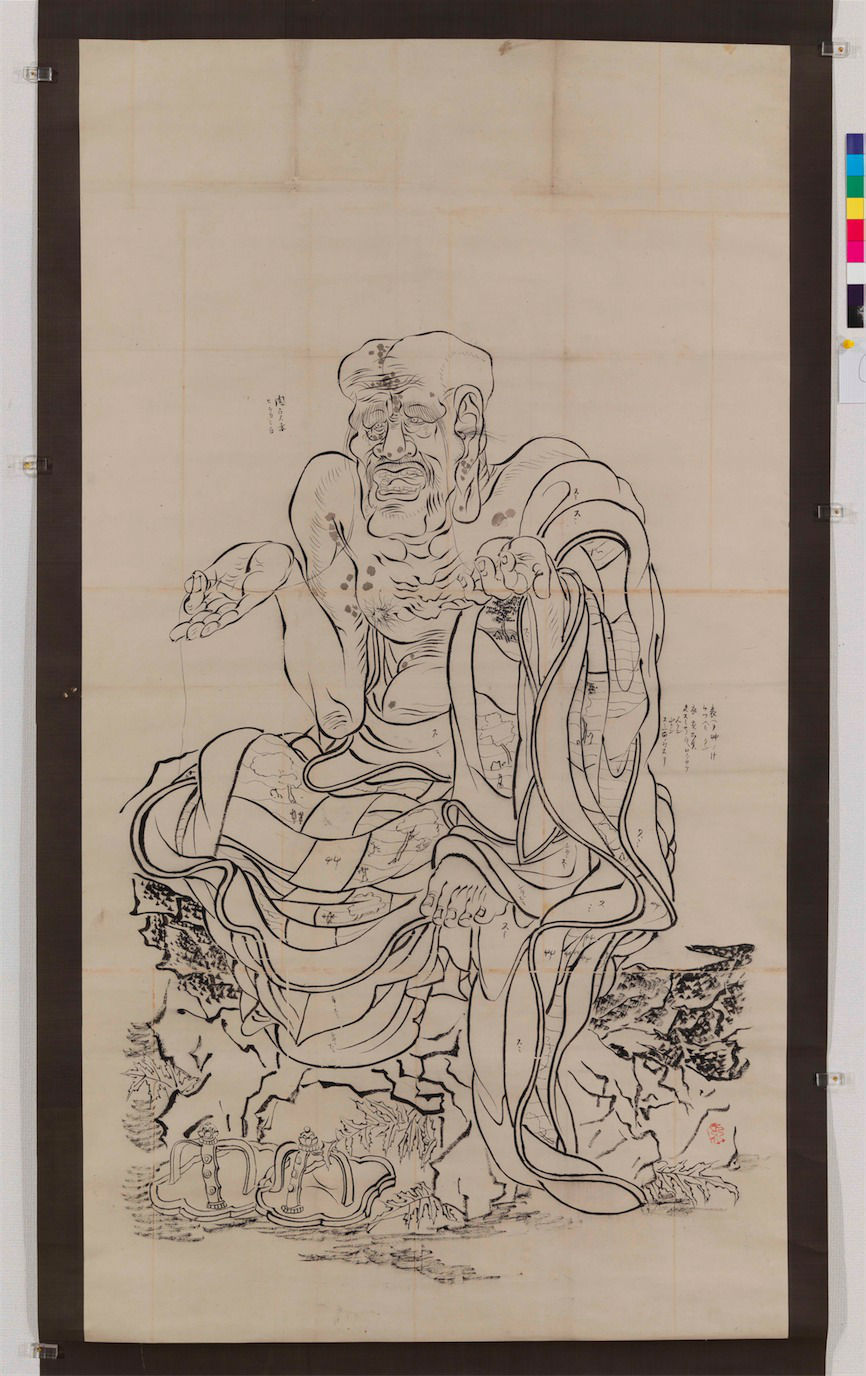
3:线型:唐朝的大画家吴道子对于线条的贡献就是他发明了莼菜描,这种描法更讲究的是行笔过程中提笔与按笔的过程,这个过程中运笔者要考虑物象,也就是人像写生中的“应物象形、模型状貌 ” 的过程,笔所形成的线条要表现形状的特征 。 莼菜描的提按运笔正好表现了古人认为的胡骨藩像的模式,印度的五百强盗被佛祖点化皈依佛教成为罗汉。贯休和尚也只是依据这些佛经依据当时人们的对于头骨的认识和贯休和尚对于线条技法的掌握 来造像。因此出现,很多人物形象与真实的人物头骨有一定的差距,这也是必要的 。以下这张莼菜描的手法表现头骨结构变化,是恰当的。
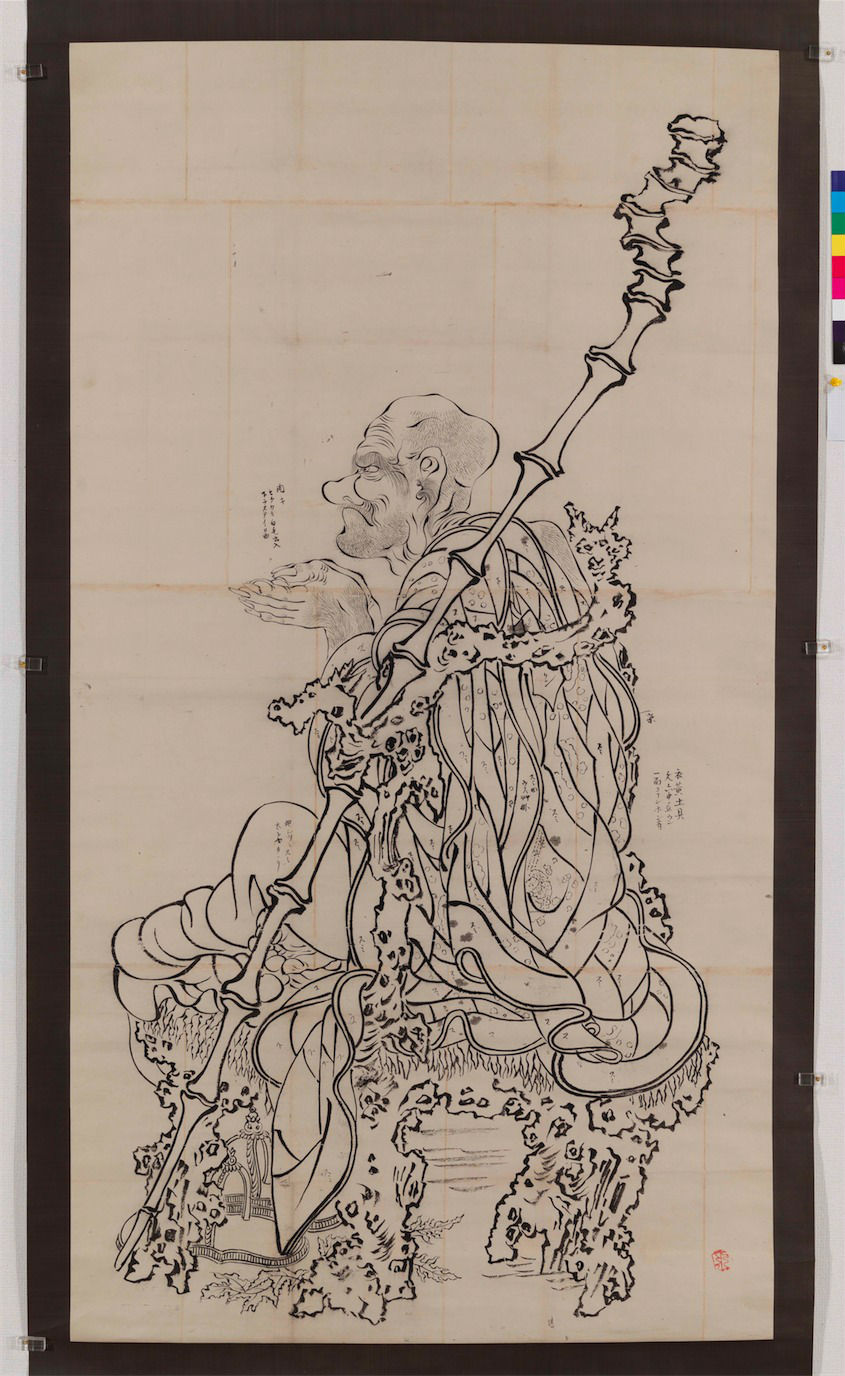
4:人物的须发。贯休和尚对于罗汉的须发是进行了必要的研究,须发的样式基本上每个人物都有区别。表现的须发与人物骨骼、肌肉 、皮肤自然结合的状态,没有虚浮的单摆独搁情况。这一点也是很可贵的,人物的胡须、各部分的毛发质感,表现的生动形象,符合毛发自然生长的基本纹理。这些须发的处理也增添了胡骨藩像的与中原人蒙古人种的一些差距。突出了印度人雅利安人种特征。
以下这张局部须发:眉毛、胡须、腋、背、耳等毛发。

以下这张:发、须、胸、臂、腹、手等毛发
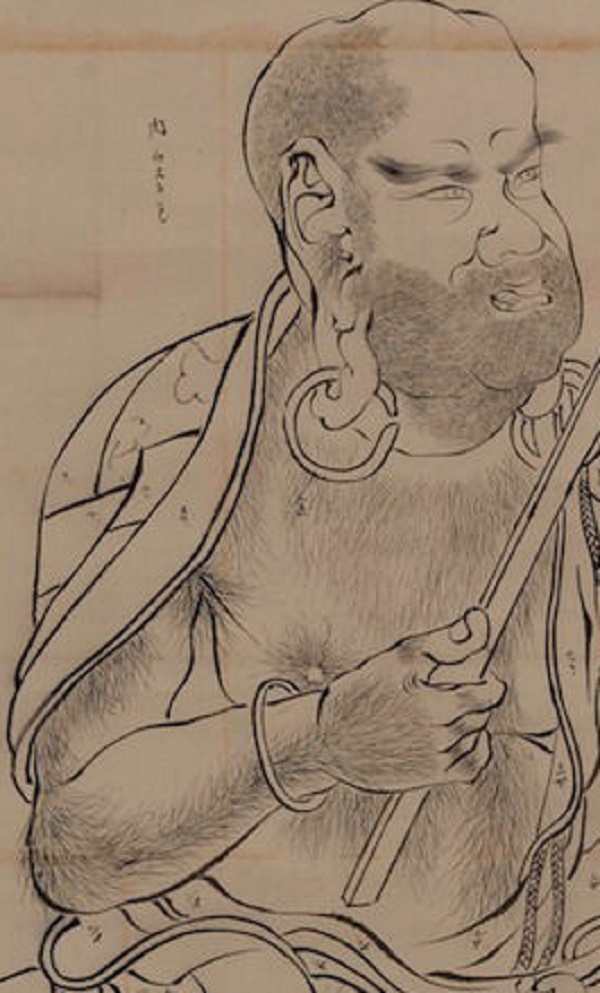
现在的印度人

以下是几张骨骼结构图
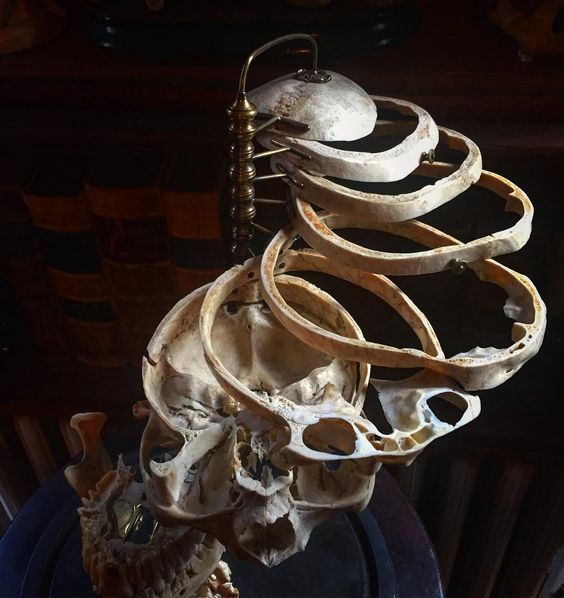
雅利安人种头骨横断面 1
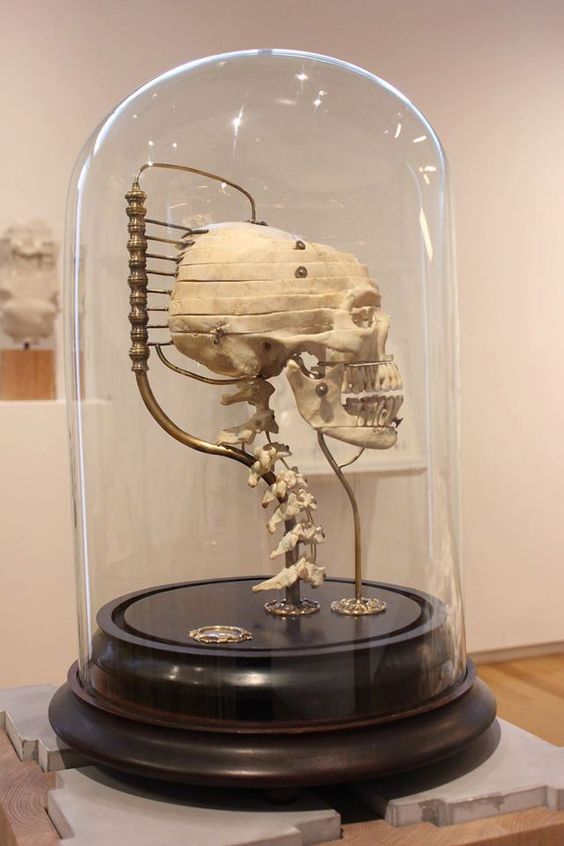
雅利安人种头骨横断面 2
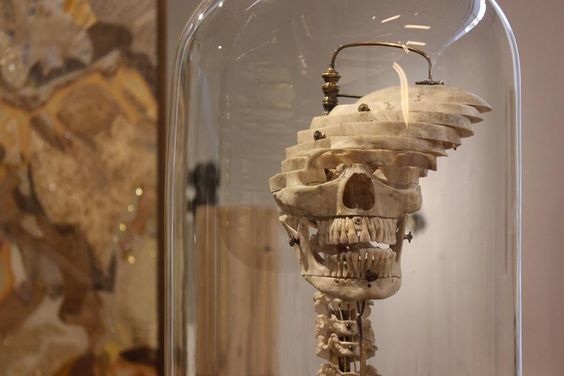
雅利安人种头骨横断面 3

头骨各局部骨骼决定头骨不是圆形

雅利安人种头骨竖断面 1

头骨各局部骨骼决定头骨不是圆形 冠状缝前后骨骼很明确 下颌骨很明确
头骨方圆结构的示意图顶颅不规则的球体,面颅与球体基本无关的立方体结构 。
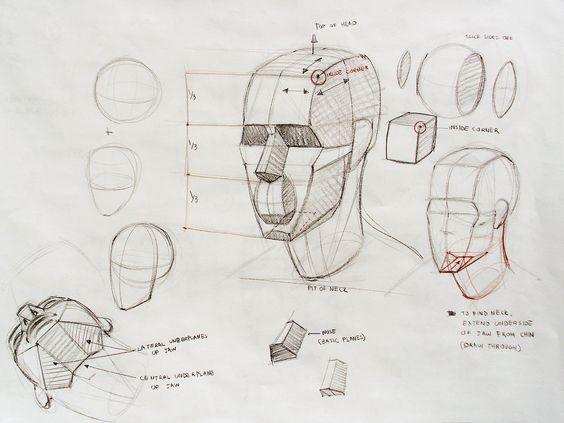
此致
敬请杨老师指教 祝您星期天愉快
刘炜
2017年1月15日
https://blog.sciencenet.cn/blog-2687371-1027644.html
上一篇:南宋贯休人物古卷模本
下一篇:想念臥龍張先生